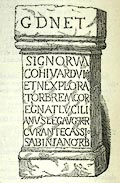







 next page
next pageof Moresby Hall, "but pretty much effaced and broken." He says, "'Tis sepulchral, and has contained the name of the person deceased, with his age, and the years he has served in the army." His copy of it, however, differs from one which Stukeley made upon the spot, and whose original note is in the possession of Mr. C. Roach Smith. The two readings are these:-
Horsley's
D M
SMERT
[O]MAC
MCoHI
HRAC
Q STII
XVICSIT
XXX QV
Stukeley's
D M
S.MERT
O.MACS
M.CATAP
HRACTAR
Q STI
X.VICSIT
XXX D.V.
I cannot but think, with Mr Roach Smith, that Stukeley's reading is the correct one, and that a prima facie case is made out for Moresby to be the MORBIUM of the Notitia. Horsley, for reasons which have not been generally acquiesced in by antiquaries, places ARBEIA, which follows MORBIUM in the Notitia, at Moresby.
An inscription very recently discovered at High Rochester confirms that place to have been the Bremenium of the Itinerary of Antoninus. It is represent in the cut below.


It may be read -
G[ENIO] D[OMINI] N[OSTRI] ET
SIGNORVM
COH[ORTIS] PRIMAE VARDVL[ORVM]
ET N[VMERI] EXPLORA
TOR[VM] BREM[ENII] COR[NELIVS]
EGNATIVS LVCILI
ANVS LEG[ATVS] AVG[VSTALIS] PR[O]PR[AETOR]
CVRANTE CASSIO
SABINIANO TRIB[VNO]
aram posuit.
To the genius of our Emperor and
of the Standards
of the first cohort of the Varduli
and of a Numerus of the Explora-
tores of Bremenium, Cornelius
Egnatius Lucili-
anus, the imperial Legate, propraetor,
under the superintendance of Cassius
Sabinianus, the Tribune,
erected this altar.
list, Two inscriptions had been found at this station many years since. In one the first cohort of the Varduli is mentioned; in the other the duplares of a detachment of the Exploratores, and the fact of their being stationed at Bremenium. The former is of the time of Elagabalus (not of Caracalla as inferred by Horsley). From that recently found we learn that these two bodies of soldiers were qtred together at this station in the time of Gordian, for it is elsewhere shewn that Egnatius Lucilianus was legate of this emperor. The Varduli, as appears by the Sydenham rescript, were in Britain in the time of Trajan; the second cohort of them is mentioned in it as surnamed Fida, a title which is also shared by the first cohort, as is proved by another inscription also very recently excavated at Bremenium, and a copy of which we here introduce from Mr. Bruce's second edition of his volume. (See the next page.)
We think with Mr. Bruce that the erased name is most probably that of Elagabalus. The word ballis we may read balneis, signifying that the public baths were restored from their foundations by the first cohort of the Varduli. Another inscription has been lately afforded by excavations. It is a votive tablet to Antoninus Pius, erected by the first cohort of the Lingones, under Lollius Urbicus, on the occasion apparently of the completion of some building. This is the Lollius Urbicus who,



 Gents Mag 1853 part 1 p.124
Gents Mag 1853 part 1 p.124